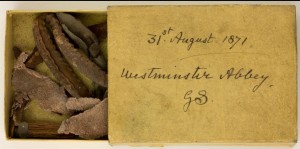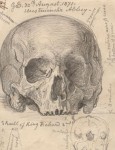 An archivist working on a six-month cataloguing program at the National Portrait Gallery uncovered pieces of wood, leather and fabric from the tomb of King Richard II in a cigarette box marked “August 31, 1871, Westminster Abbey, GS.” The GS stands for Sir George Scharf, the National Portrait Gallery’s first director, who was at Westminster Abbey on August 31, 1871, when Richard II’s tomb was opened for cleaning.
An archivist working on a six-month cataloguing program at the National Portrait Gallery uncovered pieces of wood, leather and fabric from the tomb of King Richard II in a cigarette box marked “August 31, 1871, Westminster Abbey, GS.” The GS stands for Sir George Scharf, the National Portrait Gallery’s first director, who was at Westminster Abbey on August 31, 1871, when Richard II’s tomb was opened for cleaning.
 Scharf didn’t just keep souvenirs from Richard’s coffin. He also made thorough sketches of the king’s skull and bones, including detailed measurements. The drawings are so accurate archivists believe it may be possible to reconstruct Richard’s appearance. Chroniclers at the time described him as handsome. He was just 33 when he died on Valentine’s Day, 1400, probably of starvation, while being held in captivity at Pontefract Castle by his usurper cousin, Henry IV.
Scharf didn’t just keep souvenirs from Richard’s coffin. He also made thorough sketches of the king’s skull and bones, including detailed measurements. The drawings are so accurate archivists believe it may be possible to reconstruct Richard’s appearance. Chroniclers at the time described him as handsome. He was just 33 when he died on Valentine’s Day, 1400, probably of starvation, while being held in captivity at Pontefract Castle by his usurper cousin, Henry IV.
 The contents of the box were only listed as relics from a royal tomb when catalogued, no specifics about which royal tomb it was. Scharf witnessed the opening of several royal tombs, including those of Edward VI, Henry VII and James I, so archivists had to cross-check the date with diary entries to figure out whose relics they were.
The contents of the box were only listed as relics from a royal tomb when catalogued, no specifics about which royal tomb it was. Scharf witnessed the opening of several royal tombs, including those of Edward VI, Henry VII and James I, so archivists had to cross-check the date with diary entries to figure out whose relics they were.
Krzysztof Adamiec, National Portrait Gallery Assistant Archivist (Scharf Project), says: “It was a very exciting discovery and one that reveals the hidden potential of Scharf’s papers. By matching diary entries, with sketches, notes and other material in the collection a unique record is revealed. Scharf meticulously recorded almost everything he saw and experienced. In reading his papers, one is able to reconstruct in minute detail ‘a day in the life’ of this remarkable Victorian gentleman.”
The Scharf papers held in the National Portrait Gallery’s Heinz Archive & Library comprise business, personal and family records which reflect not only the history of the Gallery, but also the wider social history of Victorian England.
Scharf was a careful observer of life in his own times and his diaries, notebooks and sketches provide a detailed record of a changing London, everyday Victorian life, and important historic events of the era. They are also an exceptional resource for the study of portraits and portraiture. Alongside his responsibility, as Director, for building-up the National Portrait Gallery’s collection, Scharf also worked in a private capacity on various external projects. He was directly involved in some of the most significant exhibitions of the Victorian period, including Crystal Palace (after its relocation to Sydenham) in 1854 and the Manchester Art Treasures exhibition in 1857.
There are 230 notebooks among Scharf’s papers in which he recorded everything from a sketch of Sir Winston Churchill as a baby to detailed views of Coventry, whose remarkably well-preserved medieval city was completely destroyed by German bombing during World War II.
The Scharf papers are being catalogued as part of the National Cataloguing Grants Programme for Archives, an ongoing project to digitize masses of historical archives from the National Portrait Gallery. You can search the online archives here. It’s surprisingly fascinating stuff, even when it’s not sketches of medieval royal skulls.